Goldsmith, painter, sculptor and draughtsman - there was seemingly no end to the versatility of Italian Renaissance artist, Andrea del Verrocchio
Strong drawing skills were considered essential to any artist's repertoire during the Renaissance, providing a backbone to so many other mediums. Verrocchio was certainly not lacking when it came to portrait drawings, with his best displayed in this section. Sadly most of his studio's drawings would be lost over the centuries due to the sheer fragility of paper at that time plus the lack of effort to preserve these artworks.
There are frequent exhibitions of artist's drawings from the Renaissance in the present day but initially these were not considered anything more than preparation for paintings, sculptures and architecture. That explains why so little was done to store and document their work in this medium. In fact many drawings would be passed around studios for others to study, perhaps unsigned and they would eventually become impossible to attribute accurately.
Art historians and researchers have compared Andrea del Verrocchio's drawings with those of his studio. Many consider Leonardo da Vinci's drawings to be the highlight from this influential art movement though Sandro Botticelli's drawings for Dante's Divine Comedy are amongst the true jewels of Florence. Similarities can be seen within their collective female portraits, such as the way in which each is composed plus also the techniques used to display the facial features.
There are only around ten drawings by Verrocchio that still remain, making it difficult to confidently conclude too much about his work in this medium. Florence itself was renowned for teaching the importance of drawing as the basis for all other work and when we consider the quality of work from his studio, it would appear that he also adhered to this view. Indeed some of his students would take this approach with them to other parts of Italy when becoming masters themselves (see Leonardo da Vinci in Milan, for example).
Andrea del Verrocchio found sketches a good way of instructing his pupils and handing over elements of commissions for them to complete themselves. It kept his production line fluid and efficient, whilst also ensuring that the quality of these completed works continued to remain high. It also enabled him to produce a type of brand within his studio, a style of portraiture that remained consistent across his assistants too. Comparing some of the drawings in this section to similar works by da Vinci and Lorenzo di Credi backs this up. Discover more about the artist in this list of Andrea del Verrocchio quotes.
The specific sketch style used by Verrocchio within his study pieces is sometimes referred to as sfumato, a smoky charcoal depiction of the head with a gradiented transition from shadow to highlight. This blend continued into Da Vinci's red chalk portraits and his use of chiaroscuro within his paintings. The artist's sculptural work, most of which do not still exist, were also believed to have taken elements of his master's portrait studies.







